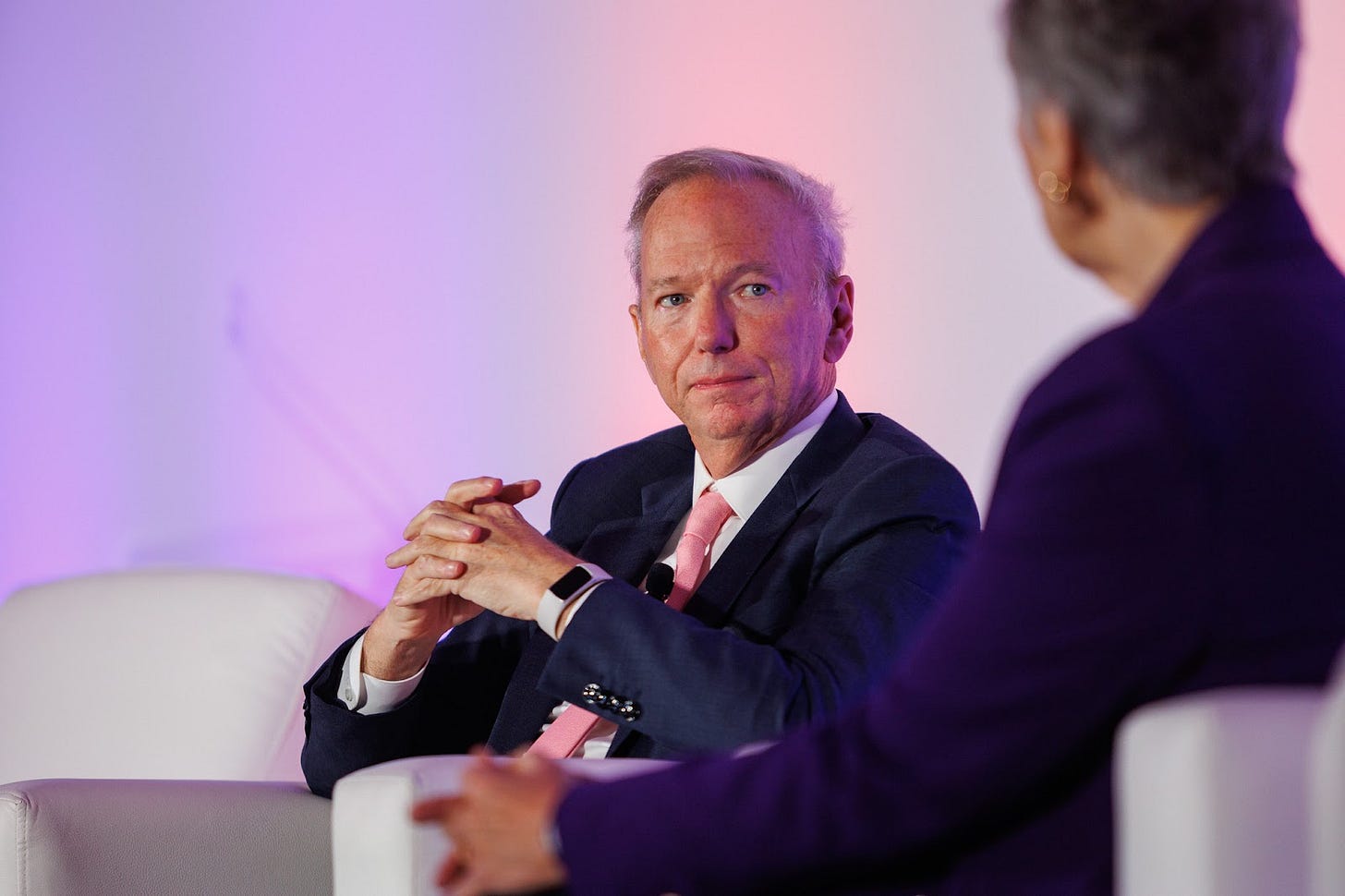Hello, I’m Ylli Bajraktari, CEO of the Special Competitive Studies Project. In this week’s edition of SCSP’s newsletter, SCSP’s Pieter Garicano, Nina Badger, and Nicholas Furst discuss important takeaways from our AI+Energy Summit last Thursday. We are grateful to everyone who participated, and we hope you will join us on October 23 for our AI+Robotics Summit. Join the waitlist here.
AI+Energy Summit
Missed the AI+Energy Summit or interested in rewatching sessions? Enjoy the entire event plus additional, green room conversations Addis and Joel conducted with our speakers on SCSP’s YouTube Channel.
Memo to the President on AI & Energy
It was great to see many of you at the AI + Energy Summit hosted by SCSP last Thursday. The purpose of the summit was to bring together top policymakers, technologists, and energy industry leaders to discuss how America can maintain its competitive edge at the intersection of AI and energy. From this day-long event, we've distilled 12 ideas:
AI and Energy Demand
The growth rate of AI energy demand is staggering. As Charles Meyers, the chair of Equinix pointed out, AI applications require 13 times more energy per data center cabinet than traditional computing. This could drive a 160% increase in global energy demand from data centers by 2030. We're facing a hockey-stick–shaped growth curve that demands urgent action. See our recent newsletter on estimating the AI power crunch.
We will probably need a "Grid New Deal" to modernize our electrical infrastructure. Dr. Costa Samaras argued that just as the Interstate Highway System transformed America, reimagining the grid as a national priority could unlock tremendous economic and technological potential. This isn't just about adding capacity, but creating a smart, flexible grid that can handle the dynamic loads of AI and renewable energy as we’ve discussed in our Energy Action Plan.
We're overlooking the potential of AI to optimize our existing energy systems. From smart grids to predictive maintenance, AI could dramatically improve efficiencies in how we generate, distribute, and store energy before we even build new capacity. This virtuous cycle of AI improving energy systems to power more AI could be a key accelerator of progress.
Policy and Regulation
We need to rethink nuclear regulations that were written for 1970s technology. Modern reactor designs are far safer and more efficient, but are being held back by outdated rules. Thoughtful regulatory reform could unlock nuclear's potential, particularly for small modular reactors (SMRs) that could provide reliable baseload power for AI data centers.
The climate benefits of clean AI infrastructure could be enormous. If we are proactive about re-shaping our energy infrastructure, the massive energy demands of AI could actually accelerate the clean energy transition, creating a virtuous cycle of innovation and deployment. This aligns the interests of tech companies, energy providers, and climate advocates in a powerful way.

Emerging Technologies and Innovation
The signature move for solving the long-term energy crunch should be taking calculated risks on emerging technologies like fusion and advanced geothermal. Fusion is much closer to reality than many realize. The potential payoffs are enormous, but we can't be paralyzed by the possibility of failure. Enhanced geothermal systems could be the dark horse winner of the clean energy race. Tim Latimer, CEO of Fervo, noted how his company’s drilling techniques have cut costs by 70% since their pilot project launch. That could make geothermal viable almost anywhere. By tapping the earth's heat at scale, it offers baseload power without some of the challenges of nuclear or fusion. We need to embrace a culture of ambitious experimentation.
Creating a regulatory ecosystem that embraces a moonshot mentality is essential for driving transformative innovation in clean energy. The DOE's "Earth Shots" initiative serves as a prime example, setting ambitious yet achievable targets that inspire both public and private sectors to collaborate and push the boundaries of what’s possible. By thinking beyond conventional technologies like batteries and exploring more advanced options such as pumped heat energy storage or cryo-compressed hydrogen, we can better address the intermittency of renewables and meet the growing energy demands of emerging technologies like AI data centers.
Public-Private Partnerships
The Department of Energy's national labs are an underused asset. We should empower them to operate more like startup incubators, partnering closely with private industry to rapidly commercialize promising energy technologies. The FASST initiative is a step in the right direction according to Helena Fu, Director of the Office of Critical and Emerging Technologies at the Department of Energy, but we need to go further in breaking down barriers between public and private sector innovation. Secretary Granholm stated that “This clean energy transition is private sector-led, government-enabled.”
Public-private partnerships are critical, but they need to focus on the right stage of innovation. Government should concentrate on early-stage, high-risk research where the private sector won't invest. This creates a pipeline of technologies that companies can then commercialize and scale.
Global Competition and Leadership
The global landscape of AI compute is shifting rapidly. According to Dr. Eric Schmidt, there are only about 6 to 7 large-scale (100,000+ GPU) AI training clusters globally. Where these are built — from the Middle East to Southeast Asia — will shape the future of AI development and energy geopolitics. The United States needs a strategy to maintain leadership while engaging allies.
We can't ignore China's massive investments in energy technology, particularly in areas like fusion and advanced nuclear. The United States needs a coherent strategy to compete, leveraging our innovation ecosystem and strengthening partnerships with allies. China's struggles with AI chip development show that raw spending isn't enough. America's culture of risk-taking and innovation remains a key advantage, but we can't take it for granted. We need to double down on our strengths in fundamental research and entrepreneurship.
The energy transition will likely be as much about retraining workers as building infrastructure. America needs investment in technical education to build the workforce that can deploy and maintain next-generation energy systems. This is especially crucial for cutting-edge fields like fusion and advanced geothermal, where talent pipelines are still developing.
Looking Forward
The AI + Energy Summit provided an invaluable platform for exploring the intersection of AI and energy, highlighting the critical challenges and opportunities that lie ahead. From the staggering growth of AI energy demand to the importance of modernizing the grid, the summit made clear that innovative, ambitious solutions are needed to meet the power requirements of the future. Key takeaways included the potential of fusion, geothermal, and advanced nuclear technologies, as well as the need for public-private partnerships to drive commercialization. By focusing on smart regulatory reform, workforce retraining, and global competitiveness, the United States can stay ahead in this evolving landscape. Many of these ideas have been recommended through SCSP’s Energy Action Plan, which serves as a broader analysis of current energy infrastructure. As we push forward, collaboration between technologists, policymakers, and industry leaders will be essential in addressing the AI power crunch and shaping a clean, sustainable energy future.
AI+Robotics Summit
In the spirit of convening experts on battleground emerging technologies, our next event will be our AI+Robotics Summit on October 23rd in Washington, DC. This effort will continue to chart a national strategy for leadership in AI-enabled robotics by convening innovation leaders to demonstrate technology directions, discuss policy implications, and identify the essential variables for U.S. competitiveness.
Yesterday, we announced expert panelists Lt. Gen. (ret.) Clint Hinote, Dr. Megan Anderson, Dr. Lorenz Meier, and Joseph Larson will be diving deep into the autonomy revolution and will explore the latest advancements in robotics in defense and intelligence.
Upcoming Events in Washington, D.C.
October 7 - 9 - NVIDIA hosts an AI Summit in Washington, D.C. to explore the latest AI breakthroughs that are transforming the public sector. The summit is expected to include over 40 virtual sessions covering advancements in generative AI, remote sensing, cybersecurity, robotics, industrial digitalization, and more.
October 11 - 13 - George Mason University hosts its sixth annual hackathon, Patriot Hacks, sponsored by SCSP.
October 23 - SCSP’s second AI+ summit, the AI+ Robotics Summit will take place in Washington, D.C. Sign up for our waitlist here!
November 1 - The Ash Carter Exchange in Boston, MA. Join the waitlist here!
November 15 - SCSP x AGI House Hackathon: SCSP is partnering with the Bay Area AI hacker house, AGI House, to host an AI Agents for Gov Hackathon @SCSP’s office in DC! Come create the future of AI agents to solve important real-world challenges. Stay tuned for more details!







